北师大版小学英语一年级(下)英文教案
- 格式:doc
- 大小:142.51 KB
- 文档页数:51
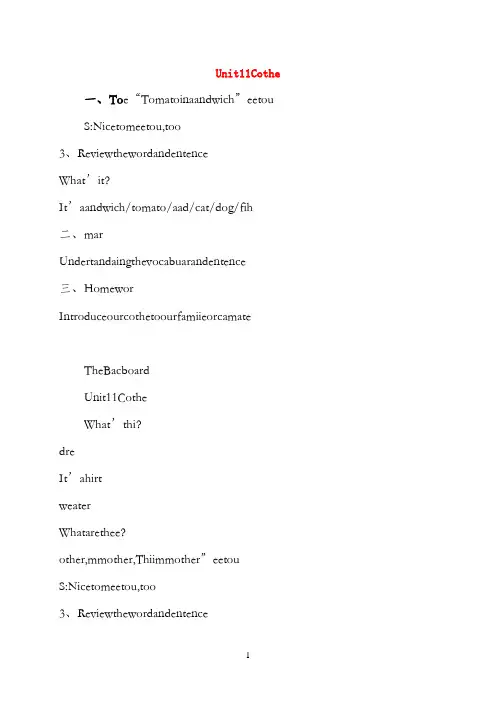
Unit11Cothe一、To e“Tomatoinaandwich”eetouS:Nicetomeetou,too3、ReviewthewordandentenceWhat’it?It’aandwich/tomato/aad/cat/dog/fih二、mar Undertandaingthevocabuarandentence三、Homewor IntroduceourcothetoourfamiieorcamateTheBacboardUnit11CotheWhat’thi?dreIt’ahirtweaterWhatarethee?other,mmother,Thiimmother”eetouS:Nicetomeetou,too3、ReviewthewordandentenceWhat’itIt’adre/hirt/weaterWhatarethee?TheareeetouS:Nicetomeetou,too3、ReviewthewordandentenceWhat’thi?It’adre/hirt/weaterWhatarethee?Theareb rea/watermeon/’round,round,round’notround2、3、AandanwerWhatiit?It’anumbrea/avioin/awatermeon/awatch4、e5、Traceandmatche8、Etenion让学生给图片着色。
(学生活动手册第36页),然后说单词,举起图片。
9、SummarUndertandaingtheword三、HomeworReadthewordTheBacboardLeonThreeanumbreaIt’a vioinawatchawatermeon教学后记:通过学习歌谣,使大部分学生都能会听说歌谣,并能理解歌谣的意思。
学生的学习兴趣很大,学生的学习效果良好。
但是有些学生对umbrea前面用的the的发音要变音,发不出来,或umbrea的前面用an,不是用a,还未注意到。
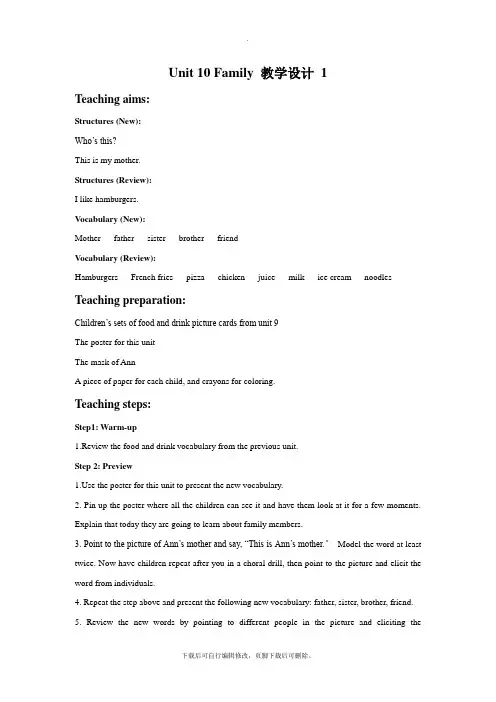
Unit 10 Family 教学设计1Teaching aims:Structures (New):Who’s this?This is my mother.Structures (Review):I like hamburgers.Vocabulary (New):Mother father sister brother friendVocabulary (Review):Hamburgers French fries pizza chicken juice milk ice cream noodles Teaching preparation:Children’s sets of food and drink picture cards from unit 9The poster for this unitThe mask of AnnA piece of paper for each child, and crayons for coloring.Teaching steps:Step1: Warm-up1.Review the food and drink vocabulary from the previous unit.Step 2: Previewe the poster for this unit to present the new vocabulary.2. Pin up the poster where all the children can see it and have them look at it for a few moments. Explain that today they are going to learn about family members.3. Point to the picture of Ann’s mother and say, “This is Ann’s mother.〞Model the word at least twice. Now have children repeat after you in a choral drill, then point to the picture and elicit the word from individuals.4. Repeat the step above and present the following new vocabulary: father, sister, brother, friend.5. Review the new words by pointing to different people in the picture and eliciting theappropriate word from the children.Step 3 presentation of new language1. Have the children look at the poster. Point to Ann’s mother in the poster and say, “This is my mother.〞Present the structure at least twice. Now have children repeat after you in a choral drill.2. Repeat the step above and, by pointing to the other people in the picture, present the other new structures: This is my father. This is my sister. This is my brother. This is my friend.3. Review the structures by pointing to different people in the picture eliciting the structure as a choral drill, then from individual children.Step 4 Talk about the story1. Have the children open the book at pages 26.Have the children look at the picture as you play the tape.2. Play the tape again and have the children repeat the words.Step 5 Extension1. Hand out a piece of paper for each child. Explain that they are going to draw pictures of their families. It will include their mother, father, sisters, and brothers. Ask them to include a drawing ofa friend.2. Children place their completed drawings on the desk in front of them. Call out items and have children point to the people in their pictures.Step 6 Set homework1. Ask children to bring in a photograph or photographs of their families and friends for the next lesson.2. Explain to the children that you want them to sing the new song to their families.。
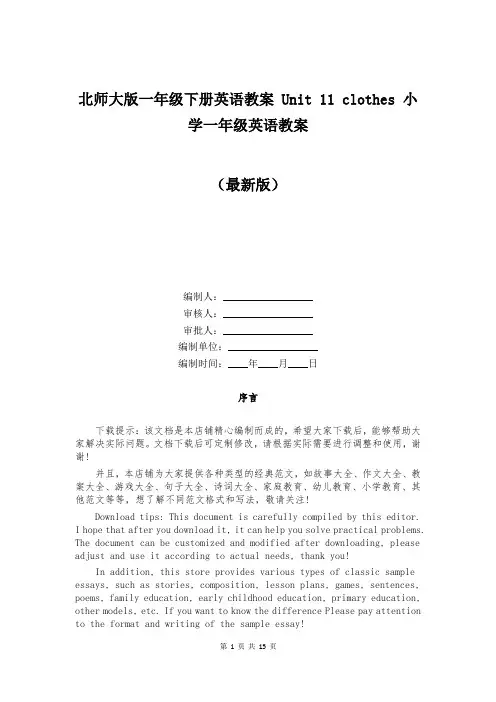
北师大版一年级下册英语教案 Unit 11 clothes 小学一年级英语教案(最新版)编制人:__________________审核人:__________________审批人:__________________编制单位:__________________编制时间:____年____月____日序言下载提示:该文档是本店铺精心编制而成的,希望大家下载后,能够帮助大家解决实际问题。
文档下载后可定制修改,请根据实际需要进行调整和使用,谢谢!并且,本店铺为大家提供各种类型的经典范文,如故事大全、作文大全、教案大全、游戏大全、句子大全、诗词大全、家庭教育、幼儿教育、小学教育、其他范文等等,想了解不同范文格式和写法,敬请关注!Download tips: This document is carefully compiled by this editor.I hope that after you download it, it can help you solve practical problems. The document can be customized and modified after downloading, please adjust and use it according to actual needs, thank you!In addition, this store provides various types of classic sample essays, such as stories, composition, lesson plans, games, sentences, poems, family education, early childhood education, primary education, other models, etc. If you want to know the difference Please pay attention to the format and writing of the sample essay!北师大版一年级下册英语教案 Unit 11 clothes 小学一年级英语教案Unit 11 clothes教案The first period (Page34-35)教学目标:掌握下面句子和单词1)They are socks . It's a dress.2)单词:dress shirt pants sweater socks shoes 的读音.重点:教学目标1,2难点:灵活运用所学的句子.教具:1,本单元的大挂图.2,图片.3,录音机.教学过程:step 1 (1) 师生问好(2) 作好复习准备step 2 New lesson一,New lesson P341,出示本单元挂图P34,指着"ken,ask,Who's this"引导学生回答:"ken".用同样的方法引导学生说"Ann 和 Mocky".2,指导挂图说:They are clothes.3,示范"clothes"3次,让学生认真听,然后让学生重复.4,指着"socks".ken say:"They are sock",对读得好的学生给予奖励.二,New lesson. P351,出示"dress"的图片,教师范读dress 3次,让学生认真听,然后让学生重复读.2,教师指着图片问:What's this 让学生回答It's a dress.重复多次.3,用同样方法学生单词"a shirt","pants","a sweater","socks","shoes".4,反复操练单词和句型It's a ……They are ……三,Practice1,听录音P34-35,让学生认真听读.2,师示范读,学生跟读.3,出示挂图,提问学生:What can you see4,pair work.是学生互相练习单词,句子.Step 3 小结本节课的内容Step 4 Home work Read P34 and P34 twiceThe second period(P36-37)教学目标:1,Trace and match2,Sing a song重点:教学目标1,2难点:Trace and match教具:图片,录音机,小卡片教学过程:Step 1 organigation(1)师生问好(2) sing a songStep 2 Revision(1)用图片复习单词:socks shoes a sweater a dress a shirt pants(2)句子:What's this /what are theyStep 3 New lesson一,New lesson P361,Open the book P36.让学生观察图片,提问:What can you see 2,让学生指着图回答,然后用笔把虚线连起来.3,让学生读读单词,找出相应的图连起来.4,Pair work.一生指,一生说.二,New lesson P37 P371,Open your books at page37. look at the pictureAsk: What can you see2,Listen to the tape.让学生拍手跟唱.三,Practice Play a game "找朋友"Step 4小结Step 5 Homework Sing the song of P37The third period (Page38-39)教学目标:1,认识物体,会说umbrella. violin watermelon. water2,会流利地读诗歌.3,找出相应数量的实物,涂色.教学重,难点:单词的读音.教具:图片,录音机,彩笔教学过程:Step 1 orbanigation(1)师生问好 (2)Sing a songStep 2 Revision(1) Revise the worlds: socks,shoes,a sweater,a dress,a shirt,pants(2)让学生看本单元挂图,提问:What's this /What are they让学生回答:It's……/They are……Step 3 New lesson一,New lesson P381,出示图片.Ask: What thisIt's an umbrella2,教师读单词3次,学生跟读,注意学生读记日记的发音. 3,用同样的方法教单词"Violin watermelon. watch".4,反复操练单词.5,Listen to the tape and point to the words二,Say the rhyme1,师示范读,并突出四个单词.2,师再范读,并配动作,让学生明白诗意.3,听录音,鼓励学生边听边做动作.4,学生私利操练.5,让学生个人表演.三,Find and color1,Ask: (1)What can you see(2) How many ……2师范读短语,让学生说出实物的颜色,并涂上相应的颜色. 3师巡查指导.4 Ask: What color are the socks让学生逐一回答.Step 4 小结Step 5 Homework Read P38-39The fourth period (Page40-41)教学目标:1,Read and match P402,Find and color重,难点:Read and match教具:图片,一个轻巧的球,彩笔,蜡笔教学过程:Step 1 organigation(1)师生问好 (2)Sing a song (3) Say the Rhyme Step 2 (1)Ask: What's this /What are they (2) Play a game.把球抛给其他同学,接到球说:I have a ……Step 3 New lesson一,New lesson P40(1)O pen your book at page 40Ask: What can you see(2)让学生读句子,然后找出相应的图连线.(3)检查校对.二,New lesson P41 Find and color1,出示挂图,让学生观察图的内容,发挥想象编故事. 2,老师说出几们东西,让学生指出来.3,.一生说,一生指.4,涂色,交换欣赏.三,Practice1,Revise Unit 11(P34-40)2,Play a game."击鼓传花"3,音乐停时,球传到谁手上,那个同学对表演好的同学,老师给予鼓励.Step 4 小结Step 5 Homework Read Unit 11之二Unit 11 ClothesThe first period一,教学目标:1,学生掌握新单词:dress , shirt , pants , sweater , socks , shoes, they , are的听,说,读.2,能够根据实物说句子:It's a …. They are …s.二,教学重点与难点:1,各新单词听,说,读的掌握.2,能较流利地说出实物:It's a …. They are …s.3,初步能区分单,复数句子的区别.三,教具:单词卡片,图片,录音机,录音带.四,教学过程:(一)复习:1,Sing the song .2,Say the rhyme.3,让学生拿着全家福或图画,利用句型:This is my ….介绍自己的家庭成员.(可同位之间互相介绍,可请个别上讲台利用实物投影仪介绍.)(二)新授:1,引入新课:"六一儿童节快要到了,在那天,小朋友们都会穿上漂亮的衣服欢度节日,Mocky,Ken和Ann也不例外,看!他们穿了多漂亮的衣服!"2,出示挂图(或利用多媒体软件出现34页的图),让学生看图,讨论.3,教师提出问题:"你最喜欢谁穿的衣服 "让学生起来回答.如果学生回答的是Ann穿着的连衣裙时,教师顺势引导:"Yes , Ann's dress is very beautiful . Ann的连衣裙真漂亮!"4,教师指着Ann穿的dress问:"What is this "引导学生回答"Dress."5,以带读,齐读,小组读,个别读等形式操练dress,a dress,It's a dress .6,用同样的方法教单词:shirt,pants,sweater,socks,shoes和句子:It's a …. They are …s.7,注意引导学生在说句子时区别两个句型,教师可简单作解释.8,让学生打开书本34页听录音,然后跟读.(三)操练:1,让学生看教师的口型猜单词.2,教师随便出示图片,学生说单词,或教师问:"What's this What are these "学生回答:"It's a …. They are …s."可全班,分组,个别回答.3,让学生把六张衣物图片分开摆在桌面上,教师说单词或句子,学生举起相应的图片.示范几次后,可让学生代替教师的角色.4,利用实物投影仪出示书本35页上部分的图(或利用多媒体课件),让学生看图,猜猜是哪一种衣物.教师用:"What's this 或What are these "问,学生用句型:"It's a ….或They are …s."回答,看哪个同学最快猜出,并准确回答,给予奖励.5,学生两人一组活动,一个学生指图片,另一个学生说句子.注意轮流指的说,完成所有图片.(四)作业:布置学生回家指35页的图说单词.The second period一,教学目标:1,进一步巩固单词:dress , shirt , pants , sweater , socks , shoes,和句子:It's a …. They are …s.2,学会唱37页的英文歌.二,教学重点与难点:1,巩固本单元的单词及句子.2,能熟练地唱英文歌.三,教具:单词卡片,图片,录音机,录音带.四,教学过程:(一)复习:1,教师出示图片问:"What's this What are these "学生回答:"It's a …. They are …s."(可全班,分组,个别回答) 2,教师说单词或句子,学生举单词卡片.3,让学生打开书本,指着书本读34,35页的课文.(二)新授:1,教师把英文歌板书在黑板上,并在歌词旁边贴上相应的衣物图片(或用多媒体课件).2,让学生看图片说衣物的名称,并逐个指出来.3,听录音机读歌词,先让学生认真听并默读,然后由教师带读两遍.4,完整地播放录音,先让学生安静地听两遍,然后轻声地跟录音唱.5,让学生拿出衣物卡片,边跟录音唱边举起相应的衣物图片.6,将全班分成两组,一组唱It's a dress . It's a dress .另一组唱Yes! It's a dress .(三)练习:1,让学生打开书本36页,让学生看图,说说Ann正在晾什么衣服.2,齐读上部分的单词.3,让学生用铅笔描每一件衣物,并涂上自己喜欢的颜色,然后把每个单词和相应的衣服连起来.4,让学生交流连线结果.(四)作业:布置学生回家读35页单词和唱37页英文歌.The third period1.Revision:1) Review the words by using the pictures.2) Tell children that they are going to pretend to be getting dressed in the morning. The teacher says "pants" and slowly mime putting on a pair of pants. Have children watch you and then join with the actions.Repeat the procedure for the other items of clothing. Make sure you exaggerate the mime and made it as slow as possible.3) Call out clothes words randomly and gave children respond by miming getting dressed.4) Now tell the children that they are going to be late for school and have to get dressed very quickly. Call out words randomly and in quick succession. Have children pretend to be putting on each item in a hurry.2. Presentation:1) Teaching the new words: umbrella, violin, watermelon, watch.Take out an umbrella and ask:T: What's thisT: It's an umbrella. Umbrella.( Repeat)2) Listen to the tape and repeat.3) Show the photograph of the new word violin and ask:T: What's this Do you know OK, let's listen to the tape.(Ask some of students to repeat)4) The students read after the teacher together.5) Repeat the procedure about for other words, watermelon and watch.2. Say the rhyme.1) Play the tape, the teacher acts out the rhyme while listening to it. Try to make children understand the meaning of the rhyme.2) Listen to the tape again, and encourage the children to say some words and do the action like the teacher.3) Read and act the rhyme together.4) Ask volunteers to come to the front to act out the rhyme.3. Read and color.Ask the students what they can see. And ask them to find what the teacher said, and then color it.Check the exercise by having children hold up their books and point to the clothes that they have colored.4. Homework:Read the new words for three times.Try to read the rhyme to their parents.The fourth period1. Revision:1) Review the rhyme from the previous lesson. Say the rhyme in a class chorus, then in groups or chose individual student to say.2) Throw a ball to one child and say the word , the child you throw to catches the ball and says the other words of clothes.2. Presentation:1) Ask the students to open the books and draw the lines in page 40.2)Check the activity by having volunteers read a sentence and show the class the picture to which it refers.3) Read all the sentences in page 40.3. Find and color:1) Have the children open their books, look at the picture and say anything they can about it in English.2) Discuss the picture briefly in Chinese.3) Explain that the children are going to look for clothes they know in the picture, and color each one.4) Check the answers.4. Extension:Have children look through old magazines or books and find pictures of the clothes for which they have learned the words in this Unit. Have each child hold up one picture and produce the structure, It's a (shirt) or They are (socks).4. Homework:Read Unit 11 to their parents.。
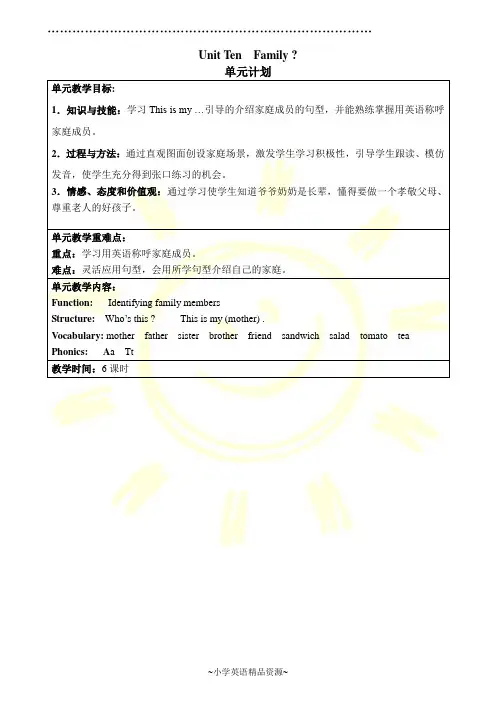
Unit Ten Family ?单元计划单元教学目标:1.知识与技能:学习This is my …引导的介绍家庭成员的句型,并能熟练掌握用英语称呼家庭成员。
2.过程与方法:通过直观图面创设家庭场景,激发学生学习积极性,引导学生跟读、模仿发音,使学生充分得到张口练习的机会。
3.情感、态度和价值观:通过学习使学生知道爷爷奶奶是长辈,懂得要做一个孝敬父母、尊重老人的好孩子。
单元教学重难点:重点:学习用英语称呼家庭成员。
难点:灵活应用句型,会用所学句型介绍自己的家庭。
单元教学内容:Function: Identifying family membersStructure: Who’s this ? This is my (mother) .Vocabulary: mother father sister brother friend sandwich salad tomato tea Phonics: A a Tt教学时间:6课时课时教案课题Unit 10 Family Lesson 1 课型课文新授教学目标1.学习句型Who’s this ?及This is引导的回答,初步了解家庭成员的英语表达。
2.利用主题图来创设情景学习主要的句型及单词。
3.激发学生爱家里的每一个成员。
教学重点难点重点:熟练掌握主体图中的句型和单词。
难点:可以根据所学句型两人熟练进行问答练习。
教具准备挂图、录音机、面具教师活动学生活动教学意图时间一、Warm-up1.Let’s sing a song2.What do you like ?二、Preview1.pin up the posterPlease look at the picture. 2.Point to the picture of Ann’s motherThis is Ann’s mother.3.point to the pictureRead after meThis is Ann’s father .This is Ann’s sister .This is Ann’s brother .This is Ann’ sfriend . 4.Review the new words by pointing to different people in the picture.三、Presentation of new language1.Hold up the mask for Ann and put it on .Point to Ann’s mother in the picture.This is my mother .2.Point to the picture Sing a songI like …Look at the pictureRepeat: motherfathersisterbrotherfriendRead the wordRepeat: This is my mother .Listen and repeat活跃课堂气氛复习有关食物的单词整体理解课文对话利用直观的图片学习新单词戴上面具创设情景学习主要功能句51510Please read after me3.Review the structures by pointing to different people in the picture四、Story1. Play the tape2.Play the tape again4.point to the picture Who’s this ?5.Two pupils make a dialogueClass is over ! Homework:1.Read the word and dialogue2.Bring in a photographs of their families and friends for next lesson. This is my father .This is my sister .This is my brother .This is my friend .Read the sentenceListen to tapeListen and repeatThis is my …Who’s this ?This is my …通过各种练习巩固新学的句型10板书设计:Unit 10 FamilyWho’s this ?This is my (sister) . 课后反思课时教案课题Unit 10 Family Lesson 2 课型课文、单词复习课教学目标1.复习课文对话,熟练掌握有关单词的认读。

Unit 12 I can swimPeriod One【Teaching contents】1.V ocabulary: can, walk, jump, swim, run, dance.2.Structures:What can you do?I can walk / jump / swim / run / dance.【Teaching key points】Listen and say the words and sentences.I can walk / jump / swim / run / dance.【Teaching difficult points】Make the dialogue and understand doing the actions.【Properties】Recorder, tape, pictures, slide show, computer, poster【Teaching procedures】ⅠOrganization.1.Sing the song. “One, two, one, two. It’s a fish, it’s a fish”.2.Greetings3.Review the words and sentences.What’s this?It’s a fish/ a monkey/ a frog / a pig / a bird/ an elephant.ⅡPresentation.1.Look at the picture. Ask and answer. And sing the song.T: Where are we going?Ss: We’re going to the zo o.T: Welcome to the zoo.2.Look at the pictures with the computer and slide show. Listen and say.T: What can you see?Ss: I can see a horse / a bird/ an elephant…T: What can the elephant do?The elephant can walk. An elephant can walk. Walk, walk, walk.3.PracticeDo the actions.Walk, walk, walk. I can walk.4.Repeat the step above and present the following new vocabulary: jump, swim.A frog/ a monkey can jump. Jump, jump, jump.A fish swim. Swim, swim, swim.5.Say the rhyme.6.Play a game. A.Say and do the actions. B.Mickey mouth7.Practice: Do the actions. Then sing the song.The horses can run. Run, run, run.“I can run.One, two, three.I can run. Look at me!”The pigs can dance. Dance, dance, dance.“I can dance.One, two, three.I can dance. Look at me!”8.Play a guessing game.9.Sing the song. Play the tape.10.SummaryUnderstand five words, the sentences and song.ⅢHomework.Say the words, sentences and do the actions. Then sing the song to your families. ⅣThe BlackboardUnit12 Period One I can swimCan you swim?Yes, I can walk /jump.I can swim/run/dance.【教学反思】Period Two【Teaching contents】1.V ocabularyReview the words: can, walk, jump, swim, run, dance.2.StructuresReview the sentences: Can you swim? Yes, I can.I can walk / jump / swim / run / dance.【Teaching key points】1.Sing the song.2.Touch and say.3.Listen and act.【Teaching difficult points】Understand saying the words in the vocabulary.【Properties】Recorder, tape, pictures, slide show, computer, poster【Teaching procedures】ⅠOrganization.1.Greetings2.Warm-upPlay, Please! It is a Simon says-style game. Explain to the children that they are only to follow your directions if you first say. “Please.”Simon says, “Please sta nd up.”Simon says, “Please jump / walk /run /dance /swim.ⅡPresentation.1.Look at my mouth. Guess and say the words.Repeat the step above for dance, walk, run, swim and jump.2.Touch and say.Explain to the children that they are going to look at some photographs of what animals can do. Say these sentences.I can dance / jump / walk /run /swim.3.Sing the song. Sing after the tape and do the actions.4.Pair Work.Divide the class into five groups. Give each group a verb flashcard.Have each group “perform” a verse for the rest of the class.5.ExtensionHold up the flashcard for jump / dance / swim / walk / run.Let the students say the verb and do the actions.7.SummaryUnderstand five words, the sentences and song.ⅢHomework.Sing the song to your families.ⅣThe BlackboardUnit 12 Period TwoSing the song.【教学反思】Period Three【Teaching contents】1. V ocabulary: x-ray, yo-yo, zebra, zoo.2.Say the rhyme:3.Read and circle.【Teaching key points】Say the rhyme【Teaching difficult points】Words【Properties】Recorder, tape, pictures, slide show, computer【Teaching procedures】ⅠOrganization1.Sing the song. I can jump.2.Greetings3.Warm-upPlay, Please! It is a Simon says-style game. Explain to the children that they are only to follow your directions if you first say. “Please.”Simon says, “Please stand up.”Simon says, “Please jump / walk /run /dance /swim.ⅡPresentation.1.Listen and say the words.This is a x-ray /yo-yo /zebra / zoo.T: What is it?S s: It’s a x-ray /yo-yo /zebra / zoo.T: Is it a x-ray /yo-yo /zebra / zoo?Ss: Yes, it is.2.Practice3.Say the rhyme.4.Read and circle.5.ExtensionListen, say and do the actions.I can jump / dance / swim / walk / run.6.SummaryUnderstand saying four words and the rhyme.ⅢHomework.Say the rhyme.ⅣThe BlackboardUnit 12 Period ThreeX-ray.It’s a yo-yo.Zebra.Zoo.【教学反思】Period Four【Teaching contents】1.Review the vocabulary and sentences with poster.2.Say the rhyme.3.Read and draw. Find color.【Teaching key points】Say the rhyme.【Teaching difficult points】Understand saying the rhyme.【Properties】Recorder, tape, pictures, slide show, computer, poster【Teaching procedures】ⅠOrganization.1. Say the rhyme.2.Greetings3.Warm-upPlay, Please! It is a Simon says-style game. Explain to the children that they are only to follow your directions if you first say. “Please.”Simon says, “Please stand up.”Simon says, “Please jum p / walk /run /dance /swim.ⅡPresentation.1.Listen and say the words and sentences with poster.T: What is it?Ss: It’s a x-ray /yo-yo /zebra / zoo.T: Is it a x-ray /yo-yo /zebra / zoo?Ss: Yes, it is.2.Say the rhyme.3.Practice4.Read and draw.5.Find and color.6.ExtensionMake an “I can” collage. Use the collage to review the structure and vocabulary from this Unit.I can jump / dance / swim / walk / run.7.SummaryUnderstand saying the rhyme.ⅢHomework.Say the rhyme.ⅣThe Blackboard【教学反思】。

Unit 12 I can swimLesson 1Teaching aims:Structures (Review):It’s a dress.They are pants.Structures (New):I can jump.Vocabulary:Can jump swim walk run dance dress shirtpants sweater socks shoesTeaching preparation:The poster for this unitTeaching steps:Step 1 Warm-up1.Explain that children are going to point to the clothes that you call out.Step 2 Preview1.Explain that today the children are going to learn how to talk about some things they can do.2.Make sure you have all the children’s attention and jump into the air. Jump again and say, “I can jump.” Model the word jump at least twice. Now have children repeat after you in a choral drill. Then elicit the verb from individuals.3.Repeat the step above and present the following new vocabulary: swim, walk, run, dance.4.Now have children do the actions when you say the words.Step 3 Story1.Have the class look at the picture as you play the tape.2.Play the tape again and have the children repeat the words.Step 4 learn the words1.Have children open their books and direct their attention to the words that appear along the foot of the page.2.Play the tape, and have them point to each picture as they hear thematching word.3.Replay the tape while displaying your copy of the page.4.Without the tape, read the words together.5.Have the children work in pairs to read the words.Step 5 Set homeworkReview the unit words.课后小结:本单元的单词为动作类,在情景引入时,可以让学生在课堂前先跟着老师做动作,既提高了学生的注意力,也加深了学生的印象。

Unit 8 AnimalsPeriod 1【Teaching aims】Structures(New):Receptive: What shape is it?Productive: It’s a square.Structures(Review):Receptive: What is it?Productive: It’s a dog.Vocabulary(New):square circle triangle star heart rectangleVocabulary(Review): dog cat rabbit fish bird mouse monkey net nest Teaching preparation: Prepare student cards, poster for this Unit, scissors, crayons, and pencils.【Teaching Steps】Step 1: Review(1)Review the words. Ask, “What is it ?” and have children respond, “It’s a dog.”(2)Repeat for all the words of animals.Step 2: Preview(1)Use the flashcards to present the new vocabulary.(2)Hold up the flashcard for square and have children look at it. Point to the square and say, “It’s a square.” Present the word, squa re. Model the word at least twice. Now have children repeat after you in a choral drill. Then point to the shape and elicit the word from individual children.(3)Repeat the step above and present the new vocabulary: circle, triangle, rectangle, star, and heart.(4)Review the six new words by holding up different shapes and eliciting the word from the children in a choral drill, and then from individuals.Step 3: Model the dialog(1)Pin up the Poster for this Unit where all the children can see it. Allow a few minutes for the children to look at it.(2)Using the cookies on the poster to present the other new structures: It’s a square, It’s a circle, It’s a triangle.Step 4: Talk about the story(1)Have the children open their books at pages 10. Have the class look at the picture as you play the tape.(2)Play the tape again and have the children repeat the words.Step 5: Story(1)Play the tape and have the children look at the pictures as they listen.(2)Play the tape again, pausing at each picture. Have the children repeat the words each time.Step 6: Set homework(1)Ask the children to remember the words and practice the sentences.【课后小结】本课的单词为形状类,而且发音较难,可以指出新单词中发音与原来所学单词相同,学生接受的会更快一些,例如:circle中的/ir/与bird中的/ir/发音相同。
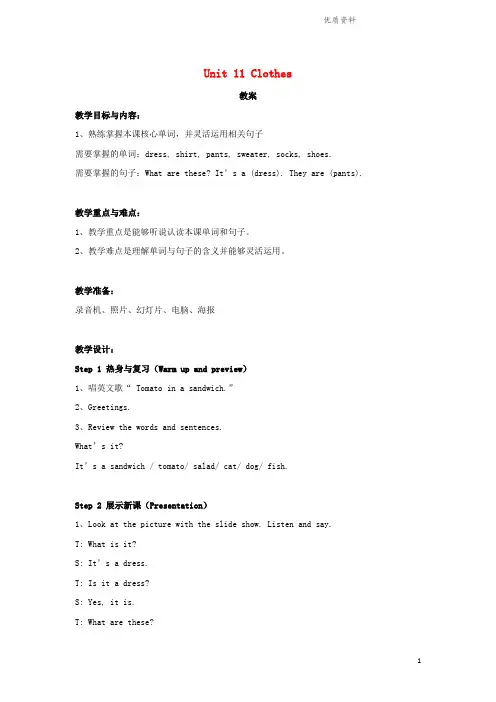
Unit 11 Clothes教案教学目标与内容:1、熟练掌握本课核心单词,并灵活运用相关句子需要掌握的单词:dress, shirt, pants, sweater, socks, shoes.需要掌握的句子:What are these? It’s a (dress). They are (pants).教学重点与难点:1、教学重点是能够听说认读本课单词和句子。
2、教学难点是理解单词与句子的含义并能够灵活运用。
教学准备:录音机、照片、幻灯片、电脑、海报教学设计:Step 1 热身与复习(Warm up and preview)1、唱英文歌“ Tomato in a sandwich.”2、Greetings.3、Review the words and sentences.What’s it?It’s a sandwich / tomato/ salad/ cat/ dog/ fish.Step 2 展示新课(Presentation)1、Look at the picture with the slide show. Listen and say.T: What is it?S: It’s a dress.T: Is it a dress?S: Yes, it is.T: What are these?They are socks.2、Repeat the step above and present the following new vocabulary: shirt, sweater.3、Look at the picture with the computer. Trace and match. Listen and say.See the umbrella / watermelon /watch. It is round, round, round.See the violin. It’s not round.4、Look at the picture with the computer. Listen and say the rhyme.See the umbrella / watermelon /watch. It is round, round, round.See the violin. It’s not r ound. See the violin. It’s long, long, long.Step 3 练习(Practice)1、Play a game. Look at my mouth, guess the words.2、Look at the picture. Listen and say.T: What are these?S: They are pants.T: Are these pants?S: Yes, they are.3、Play a guessing game.Step 4 小结(Summary)理解本课所学单词和句子,并让学生自己总结所学内容。

Unit 10 Family【第一课时】【教学目标】会认,会读,会运用以下五个单词:Father, mother, brother, sister, friend会运用句式This is my sister(father mother brother sister friend).进行介绍。
【教学重难点】能把以上五个新单词正确运用在对话中,向别人介绍自己的家庭成员。
【教学过程】一、复习上一单元学习的食物和饮料的词汇。
学生拿出食物和饮料的卡片,挑出自己最喜欢的。
请个别学生举起自己挑的卡片说:二、新内容学习1.用本单元挂图呈现新单词。
把挂图挂起来,让所有学生都看到.给学生几分钟时间看挂图,然后告诉学生,今天要学习家庭成员的名称。
学习单词mother指着Ann的母亲的图说:呈现mother这个单词.示范读这个单词三次.学生跟读。
教师指着挂图,让个别学生说出单词。
2.重复以上步骤,呈现并学习下列单词: father, sister, brother, friend。
复习以上五个新单词。
指着不同的人物,让学生说出人物的称呼。
3.学习句子This is my (mother)拿出Ann的面具戴上,让学生明白你是在假扮Ann.指着挂图中Ann的母亲说:用同样的步骤呈现其他句子.指着挂图中的其他人物说:4.复习句型指着挂图中的不同人物,学生全体说句子,再让单个学生说。
5.学生用汉语讨论图片内容。
学生Ann和Mocky在做什么他们全家在哪儿度假每幅图说的是什么事6.学生看图,教师放录音,学生认真听。
再放一遍录音,学生跟读。
三、指一指,说一说(学生活动手册)打开书,放录音,学生边听边指相应的图。
再放一遍录音,师生竞赛:看谁指得又对又快。
不听录音,学生读单词。
学生看照片.教师说:学生轮流扮演老师,互相指和说。
用同样的步骤练习其他三幅照片。
学生两人一组,一个学生指着照片,另一个说句子,互相练习说所有的图。
检查活动情况,让个别学生自愿在全班面前指图片说句子。

【导语】天⾼鸟飞,海阔鱼跃,学习这舞台,秀出你独特的精彩⽤好分秒时间,积累点滴知识,解决疑难问题,学会举⼀反三。
以下是⽆忧考为⼤家整理的《北师⼤版英语⼀年级下册《I can swim》教案【四课时】》供您查阅。
【Lesson1】 教学内容: 教学⽬标: 1. Master the new words : jump, walk, swim, dance, run 2. Can you jump/ swim? Yes, I can. 3. I can dance? 教学⽬标的检测途径 1.⽼师说,学⽣做动作。
或者学⽣说,另⼀学⽣做动作进⾏检验。
2.打乱新单词、图⽚顺序,学⽣⾃由认读。
重点难点: Teaching importance: New words learning. Teaching difficulty : use the structures to ask and answer 突破教学难点的⽅法 1.⽤动作引导单词的记忆。
2.通过歌谣,边说边做。
教具准备: 课件 教学过程: ⼀、Warm-up 1. Oral English ---Good morning! / afternoon! ---Good morning! / afternoon! ---How are you? ---I’m find. --- What day is it today? - -- It’s Monday. ---What’s the weather like today? ---It’s rain. 2.Say the rhyme : An elephant can walk, walk, walk, walk? ⼆、新课呈现(Presentation) 1.T: What can elephant do? S: Elephant. T: Yes, the elephant can walk. Today, Miss Liu will take you to the zoo, to see some animals and learn what can they do? 2.Show out a picture of elephant T : What’s this? S: ? T: What can it do? T: It’s can walk. Elicit : walk Walk, walk, an elephant can walk. ( do action) T: Can you walk? S: Yes, I can. Repeat:walk Say the rhyme again : An elephant can walk, walk, walk, walk?A frog can jump, jump, jump, jump,? 3.Practice A: Can you walk? ( one ask the next, little train) 4. Elicit: Jump Repeat:jump 5. the same way to learn swim, run. 6. ask a student to sing a song and do action One two, one, two, It’s a fish。
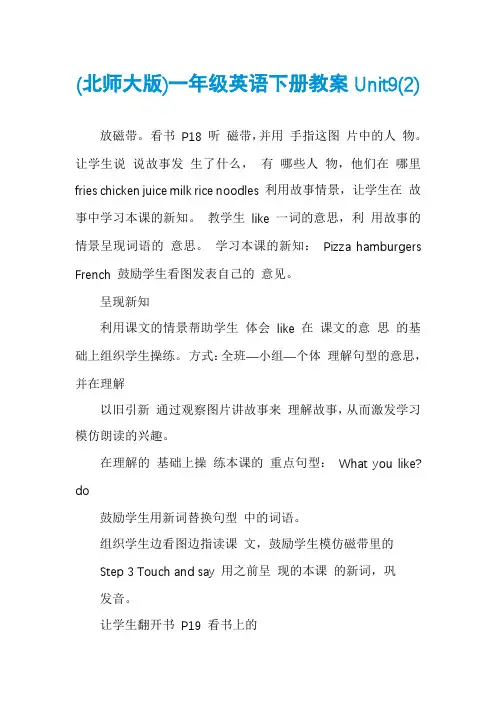
(北师大版)一年级英语下册教案Unit9(2)放磁带。
看书P18 听磁带,并用手指这图片中的人物。
让学生说说故事发生了什么,有哪些人物,他们在哪里fries chicken juice milk rice noodles 利用故事情景,让学生在故事中学习本课的新知。
教学生like 一词的意思,利用故事的情景呈现词语的意思。
学习本课的新知:Pizza hamburgers French 鼓励学生看图发表自己的意见。
呈现新知利用课文的情景帮助学生体会like 在课文的意思的基础上组织学生操练。
方式:全班―小组―个体理解句型的意思,并在理解以旧引新通过观察图片讲故事来理解故事,从而激发学习模仿朗读的兴趣。
在理解的基础上操练本课的重点句型:What you like? do鼓励学生用新词替换句型中的词语。
组织学生边看图边指读课文,鼓励学生模仿磁带里的Step 3 Touch and say 用之前呈现的本课的新词,巩发音。
让学生翻开书P19 看书上的固句型。
图片,边听边指下面的单词。
整体呈现所有词汇。
口语交际联系用活动组织学生巩固这些初步培养合作意识学生能否辨认所有单鼓励学生大胆的模仿词中的某一个听故事,并跟读翻开书P19 边听边指图单词整体感知本课的重点词汇根据书上的例子,让学生自己用图片操练对话。
T 巡视学生操练的情况,并看图听磁带中的对话,并模仿对话给予帮助单词关注学生的理解和模仿学说自己操练对话情况。
学生两人一组操练对话。
关注学生的模仿朗读情况小组展示学困生的运用情况个小组内参与情况1. 听磁带十分钟,并跟读P2-3(2 颗星) 作业设计2. 完成一,并能自己朗读P2-3(3 颗星) 3. 完成二,并主动用英语向家人朋友说出食物的名字(5 颗星) Unit9 Food and drink Lesson1 挂图板书设计What Assessment I like... pizza chicken noodles rice milk juice French fries do you like ?第二课时能用英语询问并表达自己喜欢的食物。
北师大版一年级英语下册全册教案Lesson 1单元教学目标:1、Vocabulary :Understand listening and saying the words:lion, tiger, rabbit, bird, panda.2、Structures. What’ s this? It’ s a (rabbit).3、Understand singing the song.4、Match and draw.5、Vocabulary: Understand listening and saying the words. mouse, net, nest教学重难点:1、Vocabulary :Understand listening and saying the words:lion, tiger, rabbit, bird, panda. mouse, net, nest2、Structures. What’ s this? It’ s a (rabbit).课时:四课时一、教学目标:1、Vocabulary :Understand listening and saying the words:lion, tiger, rabbit, bird, panda.2、Structures. What’ s this? It’ s a (rabbit).二、教学重、难点:1、Learn the words and sentences. Touch and say.2、Make the dialogue.三、教具:图片录音机教学过程:一、 Organization.1、Sing the song. Happy New Year.2、Greetings.T:Hello, good morning, boys and girls.T:Hi, I ’ m Miss Luo. Ss:Hello, Miss Luo3、Review the numbers one through ten.Review the words, monkey, crocodile, frog, fish, cat, dog.Review the sentence.What ’ s this?It ’ s a monkey/crocodile / frog /fish /cat / dog.二、 Presentation.1、Look at the pictures. Ask and answer.T: What’ s this?或What is it?S:It ’ s a rabbit / lion / tiger / bird / panda.T:How many rabbit?S:One rabbit / Three rabbits.T:How many dogs/fish/rabbits/birds?S:Two/Twelve/Four/Eight.2、Play a game. Touch and say.What ’ s this? It ’ s a tiger / rabbit /lion /panda /bird.3、Pair Work. Touch and say.What ’ s this? It ’ s a tiger / rabbit /lion /panda /bird.4、Listen to the tape.5、Read Unit7 together.6、Listen and number.7、Check up on the answers.8、Summary. Understand listening and saying the words and sentences.三、 Homework. Read page2-3 五次。
北师大版小学英语一年级(下)英文教案Lesson1 Teaching aims: Vocabulary: rabbit bird numbers one through ten dog cat fish Structures (New) Receptive: What is it? Productive: Its a dog、Structures (Review)Receptive: How many ? Teaching preparation:Prepare the posters and flashcards for this lesson、Teaching steps:Step1:review the numbers one through ten、 Call out numbers from one trough ten randomly、 Have children listen and hold up the correct number of fingers、 Step2:Preview Review the words dog, cat and fish with the flashcards、 Hold up the flashcard for rabbit、 Present the word rabbit、 Model the word at least twice, and then have the children repeat after you in a choral drill、Point to the picture and elicit the word from individual children、 Repeat the step above to present the new vocabulary: bird、 Review the five words by repeating the step above、 Step3:Presentation of new language Have children open their books and look at the picture、 Using Chinese, discussthe picture、 Ask children where the characters are, what they are doing, how they feel, what Ann has bought, andso on、Ask, “ What colors can you see ?” Hold up your copy of the book and point to different animals,eliciting the colors、 Now point to the dogs and ask,“ How many dogs are there?” Elicit, “ Three、” Repeat the step above for bird, cat, rabbit, and fish、 Step4:Talk about the story Have the children look at the pictures as you play the tape、 Play the tape again and have the children repeat the words、 Step5:Touch and say Have children open their books anddirect their attention to the pictures and words alongthe foot of the 、 Play the tape, and have them point t o each picture as they hear the matching word、 Replay the tape while displaying your copy of the 、 Without the tape, read the words together、板书设计:Lesson1 What is it? Its a dog、 How many ? 课后小结:由于是授课,学生对单词的把握状况不太娴熟,下节课要多练习。
Unit10 FamilyLesson OneTeaching period: The first period.Teaching contents:1、Vocabulary: mother, father, sister, brother, friend .2、Structures: Who’s this ?This is my mother /father / sister /brother /friend .Teaching key points:Take out the photos. Touch and say the words and sentences.Who’s this ?This is my mother /father / sister /brother /friend.Teaching difficult points: Make the dialogue .Properties: recorder, tape , pictures(photos), slide show, computer, poster.一、Organization.1、Sing the song. “ I like …”.2、Greetings.3、Review the words and sentences.What do you like?I like hamburgers / noodles / rice / ice cream / chicken / French fries /pizza /milk / juice.二、Presentation.1、Look at the photo with the slide show. Listen and say. Introduce the photo.T: This is my family.This is my (mother )2、Practice.T: Who’s this / that ? ( Look at the photo. )S: This is/ That’s my mother. (Touch and say. )3、Repeat the step above and present the following new vocabulary: father, sister , brother, friend.4、Play a game. Mickey mouth.5、Pair work.6、Check up on every group.7、Story.Look at the poster. This is Ann’s family. Play the tape. Play the tape again and have the children repeat the words.8、Sing the song.( paper ,)9、ExtensionHand out a piece of blank paper for each child. Explain that they are going to draw pictures of their families. It will include their mother, father, sisters, and brothers. Ask them to include a drawing of a friend. Then point to the people in their pictures and say the words.10、Summary.Understand the words and sentences .三、Homework.Point your family’s photo . Introduce your families.The BlackboardUnit 10 FamilyWho’s this / that ?fatherThis is ( That’s ) my mother.Sister.brother. friend.教学后记:Lesson TwoTeaching contents:1、Sing the song.2、Read and match.Teaching key points: Learn the song.Teaching difficult points: Understand singing the song.Properties: recorder, tape , pictures(photos), slide show, computer, poster.一、Organization.1、Sing the song. “ I like …”.2、Greetings.3、Review the words and sentences.Who’s this?This is my mother /father / sister /brother /friend .二、Presentation.1、Look at the photo with the slide show. Listen and say. Introduce the photo.T: This is my family.This is my (mother )2、Let’s talk.(Page28)3、Listen and point..4、Check up on every group.5、Play a game. Mickey mouth.6、Extension.Hand out a piece of blank paper for each child. Explain that they are going to draw pictures of their families. It will include their mother, father, sisters, and brothers. Ask them to include a drawing of a friend. Then point to the people in their pictures and say the words.8、Summary.Understand singing the song.三、Homework.Sing the song.The BlackboardUnit 10 Lesson TwoSing the song.教学后记:Lesson ThreeTeaching period: The third period.Teaching contents:1、Vocabulary: sandwich, salad, tomato, tea.2、Say the rhyme.Teaching key points: Learn the rhyme.Teaching difficult points: Understand saying the rhyme.Properties:recorder, tape , pictures(photos), slide show, computer, poster.The third period一、Organization.1、Sing the song. “ This is my mother.”2、Greetings.3、Review the words and sentences. Introduce your family.Who’s this?This is my mother /father / sister /brother /friend .二、Presentation.1、Look at the picture with the slide show. Listen and say.T: What is it?S: It’s a sandwich.T: Is it a sandwich?S: Yes, it is.1、Repeat the step above and present the following new vocabulary: salad, tomatoes, tea.2、Practice.4、Play a game. Look at my mouth, guess the words.5、Listen to the tape. Say the rhyme. Then read after the tape.6、Practice.7、Check up on every group.8、Extension.8、Summary.Understand saying the rhyme.三、Homework.Say the rhyme.The BlackboardUnit 10 Lesson ThreeSay the rhyme.教学后记:Lesson FourTeaching contents:1、Review the words: mother, father, sister, brother, brother, friend, salad, sandwich, tomato, tea.2、Review this sentence.This is my (mother).3、Read and circle. Read and draw. Find and color.Teaching key points:1、Review the vocabulary and structures for this Unit with the Poster.2、Read and circle. Read and draw. Find and color.Teaching difficult points: Understand using the vocabulary and structures.Properties: recorder, tape , pictures(photos), slide show, computer, poster.一、Organization.1、Say the rhyme. “ Tomato in a sandwich.”2、Greetings.3、Review the words and sentences. Introduce your family.Who’s this?This is my mother /father / sister /brother /friend .二、Presentation.1、Look at the pictures with the slide show. Review the vocabulary and structures for this Unit with the Poster.This is my family. This is my mother / father / sister /brother /friend.T: What is it?S: It’s a sandwich/ salad/ tomato/ tea.T: Is it a sandwich /salad/ tomato/ tea?S: Yes, it is.2、Check up on every pupil.3、Practice.4、Play a game. Look at my mouth, guess the words.5、Listen to the tape. Say the rhyme. Then read after the tape.6、Listen and number.7、Say the answers.8、Read and circle. Then check up on the answers.9、Find and color.10、Read and draw.Summary.Understand saying the vocabulary and sentences of this Unit.三、Homework.Say the rhyme.The BlackboardUnit 10 Lesson Four Say the rhyme.教学后记:。
课时教案Unit 11 Clothes单元计划单元教学目标:通过本单元的学习,学生能够识别dress,shirt,pants,sweater,socks,shoes几个有关衣服的单词,还有they,umbrella,violin,watch,watermelon五个单词,同时掌握有关名词复数的回答They are……单元教学重难点:重点: 单词的掌握,名词复数的掌握。
难点: 名字复数和句型They are……的掌握。
单元教学内容:Function: 衣服的识别Structure: It‘s a (dress). They are (pants).Vocabulary: dress, shirt, pants, sweater, socks, shoes, they, umbrella, violin, watch, watermelonPhonics: 字母u, v, w在单词中的发音.教学时间:6课时课时教案课题Unit 11 Lesson 1 Text 课型课文新授教学目标1. 学习衣着方面的用语: dress, shirt, pants, sweater, socks, shoes。
2.重点掌握名词复数, 学习They are---句型的表示方法。
教学重点难点有关衣着的单词, 名词复数的变化, 有关名词复数的回答. 教具准备教师活动学生活动教学意图时间一.Warm –up 二.Preview1 Show a card say: It’s a sweater. Let students repeat this word.2 Learn the other words: dress, shirt by repeating the step above .3 Hold up the pictures and give the example: They are pants. Read after me.4 Let students read the other sentences: They are sokes./ They are shoes.5 Review the new words.三.New languageAsk students to look at pictures:1 Now point to the dress that Ann is wearing and ask: What is it? Elicit: Dress. Present the structure: It's a dress.2 Repeat the step above for shirt and sweater and present the structure : It's a shirt, It’sa sweater.3 Present the structure: They’re shoes. Read after me.4 Repeat the step above for socks and pants. They are socks, They are pants. Say the rhyme in a class.Repeat the word.Read the other words after theteacher.Read the sentence.Look at the word cards andread them one by one.Answer the questions.意图复习预习,学习新单词。
Lesson 4Teaching aims:Structures(Review)What is it? It’s a dog.Vocabulary: dog cat rabbit fish bird mouse monkeyTeaching step:Step 1: Warm-up(1)Review he rhyme from the previous lesson. Have children say the rhyme in a class chorus. Then say it in teams or chose individual student to say the rhyme. (2)Encourage students singing animal songs or saying animal rhyme while imitating the animal.Step 2 Review with poster(1)Using Chinese, ask them to describe the picture. Ask where the characters are, what they are doing and how the children think the characters feel.(2)Say, “Point to a dog.” and have the children point to a dog. Repeat this for bird, cat, fish, and rabbit.(3)Practice asking yes/no questions. Point to the rabbit and ask, “Is it a dog?”Elicit, “No” or “No, it is a rabbit.”Step 3: Match and color(1)Say, “Open your books.” Have the children look at the picture.(2)Say “Find a dog.” Have children point to a dog in the picture.(3)Repeat the step above for fish, cat, rabbit, bird, mouse and monkey.(4)Draw children’s attention to the text at the top of the page. Have them read each sentence silently.(5)Explain that they are going to match each sentence with one of the animals.(6)Set enough time for children to do the matching activity. Then have them color each animal according to the sentences.Step 4: Find and color(1)Have the children open their books and look at the picture.(2)Explain that in the picture there are some animals. Give children a few minutes to look for the animals.(3)When all the children have found the animals, they can color them and share their pictures with class.Step 5: Set homeworkReview the words课后小结:在做练习之前先对单词进行复习,学生熟练掌握之后,再做单词连线,学生掌握的比较好。
Unit 7 AnimalsLesson 1Teaching aims:V ocabulary: rabbit bird numbers one through ten dog cat fish Structures (New)Receptive: What is it?Productive: It’s a dog.Structures (Review)Receptive: How many…?Teaching preparatio n:Prepare the posters and flashcards for this lesson.Teaching steps:●Step1:review the numbers one through ten.Call out numbers from one trough ten randomly. Havechildren listen and hold up the correct number of fingers.●Step2:PreviewReview the words dog, cat and fish with the flashcards.Hold up the flashcard for rabbit. Present the word rabbit.Model the word at least twice, and then have the childrenrepeat after you in a choral drill. Point to the pictureand elicit the word from individual children.Repeat the step above to present the new vocabulary: bird.Review the five words by repeating the step above.●Step3:Presentation of new languageHave children open their books and look at the picture.Using Chinese, discuss the picture. Ask children where thecharacters are, what they are doing, how they feel, whatAnn has bought, and so on.Ask, “What colors can you see ?” Hold up your copy ofthe book and point to different animals, eliciting thecolors.Now point to the dogs and ask, “How many dogs are there?”Elicit, “Three.”Repeat the step above for bird, cat, rabbit, and fish.●Step4:Talk about the storyHave the children look at the pictures as you play the tape.Play the tape again and have the children repeat the words.●Step 5:Touch and sayHave children open their books and direct their attentionto the pictures and words along the foot of the page.Play the tape, and have them point to each picture as theyhear the matching word.Replay the tape while displaying your copy of the page.Without the tape, read the words together.板书设计:Lesson 1What is it?It’s a dog.How many…?课后小结:由于是新授课,学生对单词的掌握情况不太熟练,下节课要多练习。
Lesson 2Teaching aim s:●Structures(Review)What is it? It’s a dog.V ocabulary: dog cat rabbit fish birdTeaching preparatio n:The flashcards for this Unit.Teaching step s:●Step 1:PreviewReview the flashcards for this Unit.Collect together pictures of fish, dogs, cats, rabbits,and birds.Cover one of the pictures with a piece of card so that whenyou hold it up, the children cannot see what it is.Have the children guess what animal it is. Elicit “It’sa fish.”Repeat the steps for dog, cat, rabbit, and bird.●Step 2:Trace and matchHave the children look at the pictures to be traced at page4.Have the children trace the animals and say the sentencesfor each one.Now have children read the sentences on the page. Directthem to join the words to the matching pictures with apencil.●Step 3:Sing the songRead the words and have children listen and follow thewords silently.Play the tape without stopping. Have children listen andpoint to each number and animal as it mentioned.Play the song again and have children join in with the words.As they chant they should point to the illustrations.Divide the class into five groups. Assign each group twoconsecutive numbers. Each group sings a verse and the classmimes or does an imitation of the animals mentioned.●Step 4:Set homeworkAsk the children to remember the words.课后小结:学生对数字掌握的比较熟练,但个别学生对句子掌握的不是太好,下课后需多加辅导。
Lesson 3Teaching aims:Review: What is it? It’s a dog.Teaching preparation:Flashcards for cat, dog, rabbit, fish, and bird.Pencils or crayons.Teaching step s:●Step 1:Listen and practiceHave the children open their books at page 6.draw theirattention to the photograph of the mouse. Point to thepicture on the page and say, “This is mouse.”Play the tape, pointing to the photograph of the word.Now replay the tape and have children touch the photographas they listen.Play the tape one more time and have children listen andrepeat the word, mouse.Repeat the procedure above for the words monkey, net andnest.●Step2:Say the rhymeTell the children that they are going to learn a thyme aboutanimals.Play the tape, the teacher acts out the thyme whilelistening to it. Try to make children understand themeaning of the thyme.Play the tape for third time, have the children listen tothe tape and encourage them to say one or two words withthe tape.Play the tape again and again and have the children actor clap their hands with the rhyme, have them shout outwords or phrases.Have the children act out with the teacher while tryingto say the rhyme.●Step 3:Match and drawHold up your copy of the book, point to each drawing andelicit the name of the animal.Draw children’s attention to the seven pictures of petanimal habitats. Explain that they are going to decidewhich animal lives where.Now have the children copy the line drawing of each animalinto the correct place.●Step 4:HomeworkAsk each child to make a mask of their favorite animal. 课后小结:这节课作练习效果比较好,学生掌握单词的熟练程度好多了。